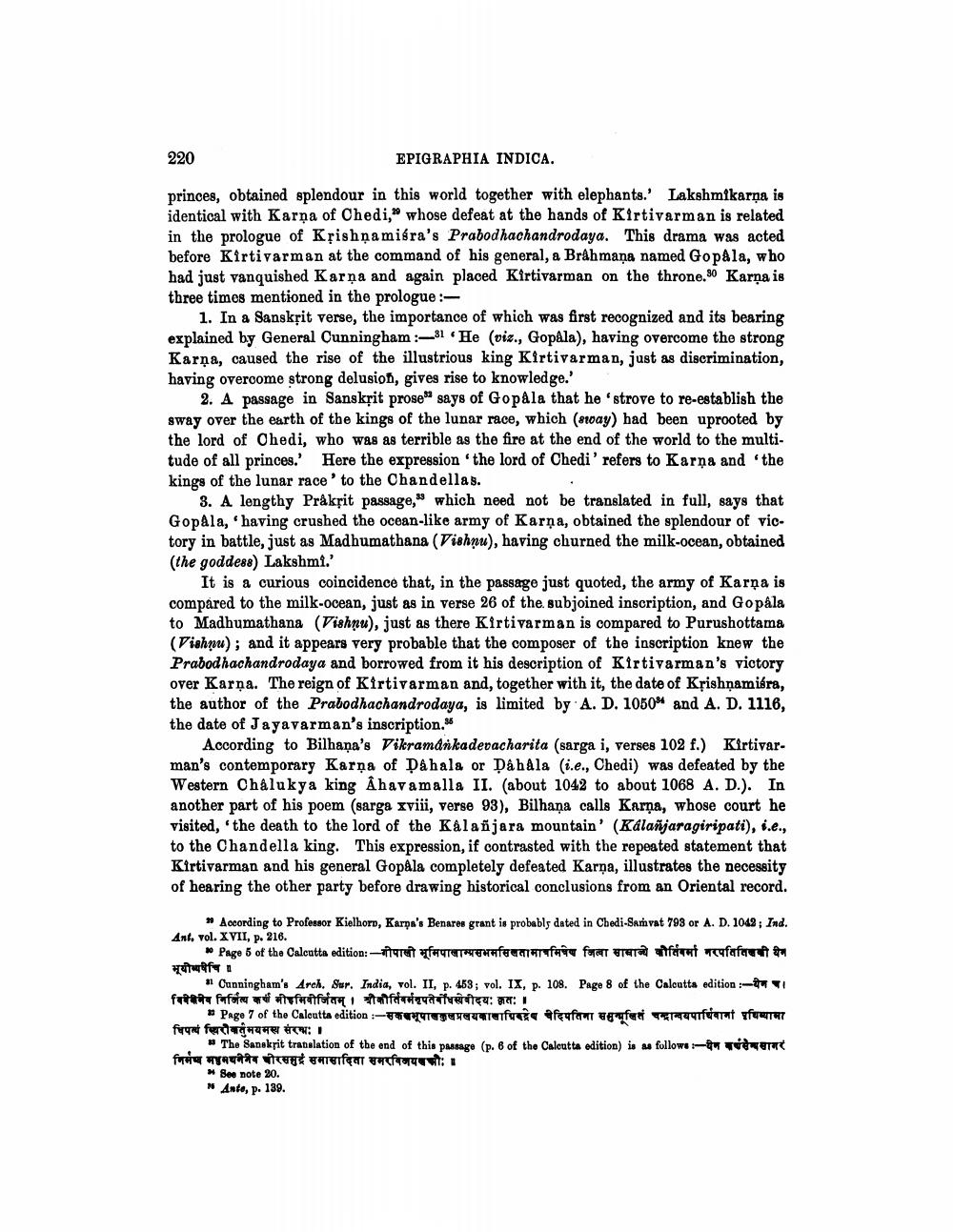________________
220
EPIGRAPHIA INDICA.
princes, obtained splendour in this world together with elephants. Lakshmikarņa is identical with Karna of Chedi," whose defeat at the hands of Kirtivarman is related in the prologue of Krishņamisra's Prabodhachandrodaya. This drama was acted before Kirtivarman at the command of his general, a Brahmaņa named Gopala, who had just vanquished Karna and again placed Kirtivarman on the throne.80 Karna is three times mentioned in the prologue :
1. In a Sanskřit verse, the importance of which was first recognized and its bearing explained by General Cunningham :-81 He (viz., Gopala), having overcome the strong Karņa, caused the rise of the illustrious king Kirtivarman, just as discrimination, having overcome strong delusion, gives rise to knowledge.
2. A passage in Sanskrit proses says of Gopala that he'strove to re-establish the sway over the earth of the kings of the lunar race, which stoay) had been uprooted by the lord of Ohedi, who was as terrible as the fire at the end of the world to the multitude of all princes. Here the expression 'the lord of Chedi' refers to Karna and the kings of the lunar race' to the Chandellas.
3. A lengthy Prakrit passage, which need not be translated in full, says that Gopala,'having crushed the ocean-like army of Karņa, obtained the splendour of victory in battle, just as Madhumathana (Vishnu), having churned the milk-ocean, obtained (the goddess) Lakshmi.'
It is a curious coincidence that, in the passage just quoted, the army of Karna is compared to the milk-ocean, just as in verse 26 of the subjoined inscription, and Gopala to Madhumathana (Vishnu), just as there Kirtivarman is compared to Purushottama (Vishnu); and it appears very probable that the composer of the inscription knew the Prabodhachandrodaya and borrowed from it his description of Kirtivarman's victory over Karna. The reign of Kirtivarman and, together with it, the date of Krishnamiéra, the author of the Prabodhachandrodaya, is limited by A. D. 105094 and A. D. 1116, the date of Jayavarman's inscription.
According to Bilhana's Vikramankadevacharita (sarga i, verses 102 f.) Kirtivarman's contemporary Karna of Då hala or Dahala (i.e., Chedi) was defeated by the Western Chåluk ya king Åhavamalla II. (about 1042 to about 1068 A. D.). In another part of his poem (sarga xviii, verse 93), Bilhana calls Karna, whose court he visited, the death to the lord of the Kalañjara mountain' (Kalañjaragiripati), i.e., to the Chandella king. This expression, if contrasted with the repeated statement that Kirtivarman and his general Gopåla completely defeated Karņa, illustrates the necessity of hearing the other party before drawing historical conclusions from an Oriental record.
*According to Professor Kielhorn, Karpe's Benares grant is probabls dated in Chedi-Samvat 798 or A. D. 1042; Ind. Ant. vol. XVII, p. 218.
* Page 5 of the Calcatta edition: f H f H falla format a fárat afafane Tuttf
* Cunningham's Arch. Sur. India, vol. II, p. 453 ; vol. IX, p. 108. Page 8 of the Calcutta edition : विवमेव निर्जित्य कर्ण मीहमिवीर्जितम् । बौकीर्तिवर्मनृपतेाँवस्थेवीदयः कृतः ।
Page 7 of the Caleatta edition :-**UTC area efeferat afat 7614ferat fu417 धिपत्यं स्थिरीकर्तुमयमस्य संरभः ।
# The Sanskrit translation of the end of this passage (p. 8 of the Calcutta edition) is as follows:- TO T T निर्मण मामधनेनैव पीरसमुई समासादिवा समरविनयपीः ।
* See note 20. * Ante, p. 139.




